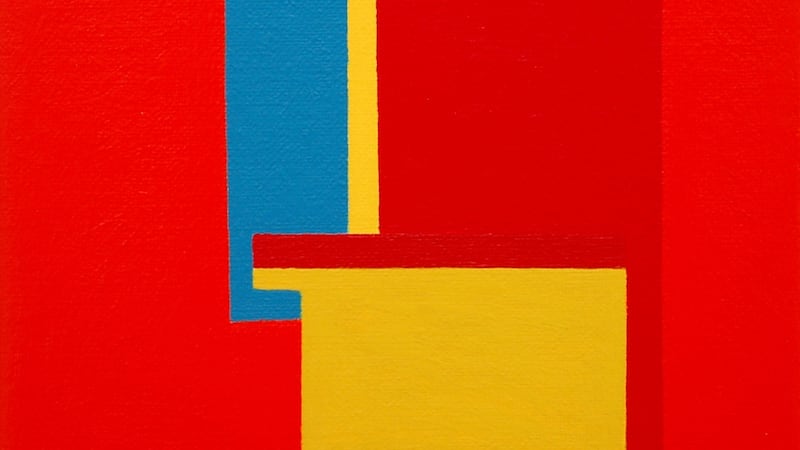Paper Bloom – Katie Moore
Civic Offices, Ballina, Co Mayo
★★★★★
When the Mayo County Council arts office and the Jackie Clarke Collection in Ballina looked for proposals from artists to complete a residency in commemoration of the 1916 Rising, there was no guarantee that the successful applicant would be from Mayo. In fact the expectation was that the artist chosen would probably be from farther afield.
Then, as Mayo's public art co-ordinator, Gaynor Seville, put it, they were blown away by the strength of the proposal from Katie Moore, who is from Foxford and was a relatively recent graduate at GMIT's Cluain Mhuire campus in Galway.

Before studying design and textiles at GMIT, Moore had worked as a milliner. Her graduation piece was an exceptionally ambitious installation, Hospital Gown. It consisted of 36 spectral figures in the form of hospital gowns arranged on wire frames. She machine-sewed and hand-stitched the gowns from lengths of medical gauze. Inspired by her experiences as a cystic fibrosis patient, the installation symbolically represented the 36 people with the condition at that time across the Galway-Mayo region.
When Jackie Clarke died suddenly in 2000, he left an extraordinary personal collection of more than 100,000 items relating to 400 years of Irish history. It included a vast range of material: letters, legal documents, photographs, masses of printed ephemera, maps, manuscripts and books, many extremely rare, and much more.
Clarke was born into a Ballina business family in 1927. Growing up with an interest in republican history, he visited the Irish Book Bureau when he was 14 and met 1916 veteran Joe Clarke. From that moment on he was a collector, a passion he pursued throughout his life in Ballina, where he set up shop by the time he was 20.
The collection was assessed, organised and made accessible by historian Sinéad McCoole, and it now has a home in the revamped former Provincial Bank building on Pearse Street, Ballina. On an exploratory visit, Moore says she found it overwhelming. The idea that one person, unaided, had built up such a treasure and a resource was breathtaking. She decided to pursue that sense of being overwhelmed in what she proposed as a residency project.
The result is Paper Bloom, which hinges on the visualisation of individual experience in relation to and in the context of a whole society. Although the collection might be viewed in an academic, detached way, a recurring sense of intimacy – the fact that item after item has an immediate physical and emotional connection with a person in their historical time and space – breaks through any imposed distance.
Then there is Clarke’s unwavering personal commitment. Moore refers these feelings back to the few who acted in the interests of the many in throwing themselves into the Easter Rising.
She looks to the awful aftermath – the lowest point in terms of the individual experience of the leaders. Her installation focuses on Patrick Pearse in his cell in Kilmainham Gaol before his execution. Flowers play a powerful symbolic role in the practice of remembrance. Clarke, she noticed, had a wallet in which he amassed Easter lily ribbons with paper flowers. Ribbons did not feature in any way in the Rising but, from about 1926, they became the symbol of 1916 and the republican cause.
Moore liked the closeness of the symbol to Clarke: the ribbons pressed together in a wallet, tucked into a pocket. She set out to design a pattern for a fabric lily. She hoped, she says, to configure the bloom as an elegant white vessel, a blank slate and an elegant form in one.
In Foxford, she enlisted 22 volunteerswith the skills to join her in making 5,500 fabric blooms.
In the darkened Civic Offices in Ballina, a framework matching the dimensions of Pearse’s cell stands in the middle of a room.
Its walls are composed of blocks of massed fabric lilies, making a rhythmic, undulating pattern. We cannot see in, but the room radiates light, filtered through the mediating walls of blooms. One cluster of blossoms is set aside, in one corner, perhaps underlining the bond between individual and society. From concept to realisation, it is an exceptionally effective work.
- Until June 25th, paperbloom.net, clarkecollection.ie
James O'Connor
Taylor Galleries, Dublin
★★★★
Dubliner James O’Connor studied at NCAD in the 1970s, but moved almost immediately to Munich and settled there. A quiet, self-effacing, constant presence in Irish visual art, he has continued to exhibit in Ireland at Taylor Galleries. His current show there, of paintings and collages, is outstanding. He has always worked in an immersive, meditative way.
Early on, O’Connor made irregularly shaped works, usually on paper. He liked the idea of dealing with fragments and with creating “a space that would remain open”. A tentative, provisional quality came through and continued to do so when he went on to make very spare, linear works on paper. This was not indecisiveness, as becomes clear in the new paintings and collages, but was more to do with preserving that sense of openness.
The collages are specified as “working collages” because O’Connor turns to them when work stops on a painting. Both collages and paintings depend on the tenuous balance of a series of interlocking, intensely coloured forms. But colours and forms opt out of a neat elegance. You could say that the compositions are, on second glance, slightly jarring and subtly energised: a sharp meeting of colours or a sudden shift in an angle will prompt us to look again and reconsider what the artist is trying to do. The work is abstract, but clearly resonates with our day-to-day experience of the world.
- Until June 11th, taylorgalleries.ie












